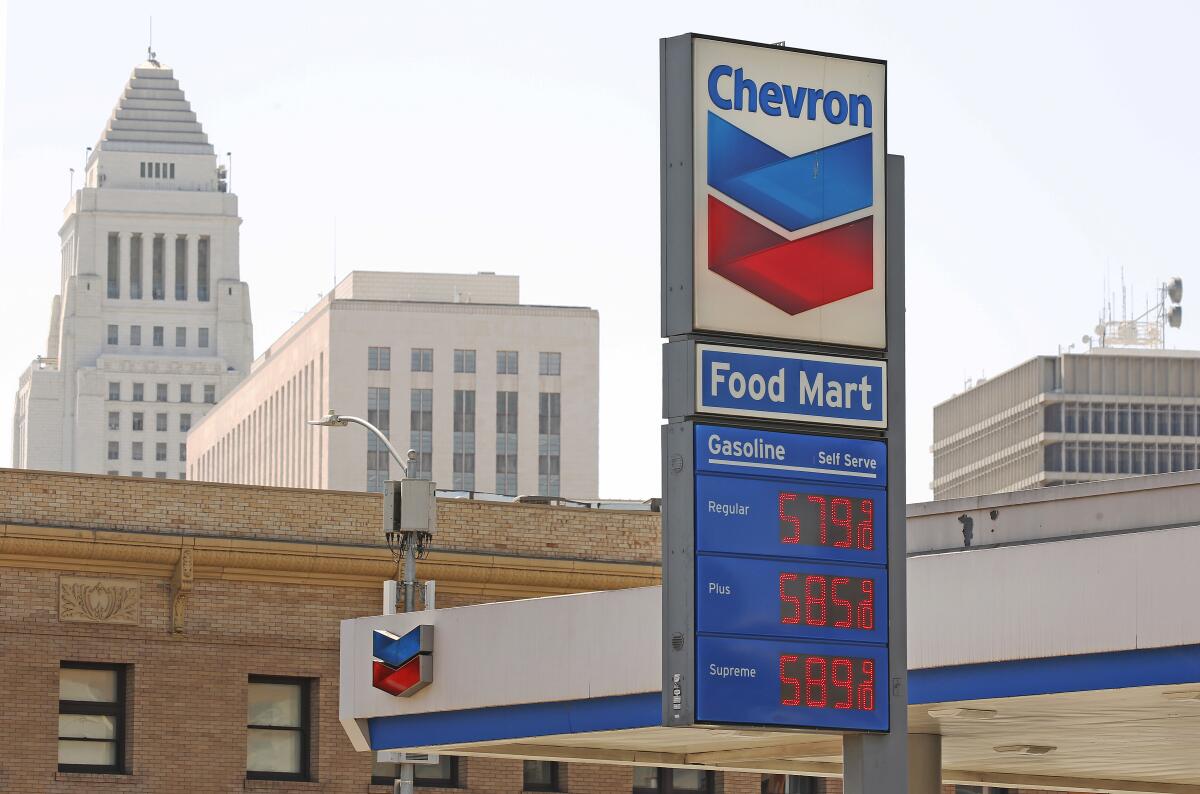Column: Why do gas prices rise quickly and come down really, really slowly?

Oil prices topped $70 a barrel Monday for the first time in over three months thanks to the latest mess in the Middle East. Higher prices at the gas pump seem sure to follow.
And if you’re like me, you’ll probably ask yourself: Why is it that gas prices always seem to go up really fast whenever there’s turmoil in the oil market and come down again really, really slowly?
“It isn’t just a perception,” said Lea-Rachel Kosnik, an energy economist at the University of Missouri-St. Louis. “There is some evidence that gas prices rise faster than they fall.”
Thus the more pertinent question: Are oil companies and gas stations ripping us off? Isn’t this just price gouging?
“One can call it that if they want,” Kosnik told me, although she and other experts I spoke with were reluctant to use such terminology.
“Price gouging isn’t really a technical term,” she said. “So it’s not like there is a way to define it empirically and say yes, we’ve crossed it, or no, we haven’t.”
But there’s sufficient historical evidence to wonder why gas prices routinely behave in a way that favors businesses and punishes consumers.
“The perception is correct,” said Robert Kaufmann, an energy economist at Boston University. “Gas prices do go up quickly and come down very slowly. But I wouldn’t say we’re being gouged.”
Rather, it’s complicated. “There are a number of factors at work,” Kaufmann said.
These can include limited inventory of gasoline, especially in California, where strict environmental standards add to refining costs.
Another factor is that people still have to drive every day, which means it’s difficult for consumers to signal their displeasure by cutting demand for higher-priced petrol. That reduces economic pressure for price cuts.
And perhaps the biggest hurdle to leveling charges of price gouging: It’s darned hard to prove.
Stephen Brown, an economist at the University of Nevada, Las Vegas, and senior editor of the academic journal Energy Policy, said that dubious pump prices “are likely the result of tacit collusion” and that “the sellers are likely taking advantage of consumers.”
However, “a lack of competition is a primary cause,” he said, rather than a deliberate (and illegal) effort by industry players to fleece customers.
In other words, everyone raises prices quickly and lowers them slowly because, well, they can.
And because every other gas station is doing it, you’d be a fool not to do the same.
Station operators don’t deny that pump prices often rise faster than they fall. But they insist nothing nefarious is going on.
“Gas stations are not trying to take advantage of an unfortunate circumstance,” said James Allison, spokesman for the California Fuels and Convenience Alliance, a trade group representing about 12,000 gas stations statewide.
“They’re not trying to gouge people,” he said. “They’re just responding to what’s going on in the marketplace.”
The key element, Allison said, is uncertainty.
“When something interrupts the supply chain, there can be an instant reaction,” he said. “It can then take a significant amount of time to deal with that uncertainty and get things back on track.”
Fair enough. All markets price uncertainty into goods and services, and it’s only prudent for a business to anticipate the worst so it’s not caught unprepared.
That said, it’s hard to escape the conclusion that consumers are being taken advantage of — or soon could be, depending on coming days.
A gallon of regular gasoline was going for an average of $3.61 on Monday in Los Angeles, one cent lower than a week ago and 16 cents lower than a month before, according to the Automobile Club of Southern California.
The statewide average was $3.55 on Monday, two cents lower than last week and 18 cents lower than last month.
Iran’s oil exports are limited by economic sanctions, which has kept a lid on economic fallout from the current tension between Washington and Tehran.
The concern among industry analysts is that the conflict may expand to other oil-producing countries — not least Saudi Arabia — which could have catastrophic effects on oil supplies and the global economy.
Moreover, nearly a quarter of the world’s oil moves through the narrow Strait of Hormuz, which is in Iran’s backyard. A military conflict in the region would almost certainly disrupt global supplies.
Marie Montgomery, a spokeswoman for AAA, said the group’s analysts are still watching to see how things play out. If the current situation is resolved quickly, pump prices could stay relatively flat, she said.
If things worsen, all bets are off.
David Rapson, co-director of UC Davis’ Energy Economics Program, said some in the field refer to the fast-rise, slow-descent dynamic for gas prices as “rockets and feathers” — that is, they go up like a rocket and drift gradually downward like a feather.
Information is key, he said.
“Oil companies and gas stations know how others are setting prices, and they adjust their prices to match those prices,” Rapson observed. “That’s why prices can go up quickly.”
They come down slowly, he continued, because consumers are at a disadvantage. People likely don’t know what’s happening in the broader market or even what gas prices might be on the other side of town.
“Consumers have more important things to do with their lives,” Rapson said. “They’re not going to drive around looking for the lowest price.”
But that doesn’t mean we’re powerless.
Apps such as GasBuddy and Gas Guru can help you find the cheapest gas in your area. This, in turn, will allow you to flex your economic muscle by reducing sales at gas stations that keep prices too high for too long.
It’s all about sending a message. If your local station seems to be taking advantage of market price swings, take your business elsewhere. The station owner will notice any decline in sales and will set pump prices accordingly.
Remember, though: This is a time of year when demand for gas is typically lower. AAA says prices will start their annual march higher in the spring, perhaps rising by as much as $1.50 a gallon.
If the global oil market hasn’t calmed down by then, prepare for some ugly times at the pump.
More to Read
Inside the business of entertainment
The Wide Shot brings you news, analysis and insights on everything from streaming wars to production — and what it all means for the future.
You may occasionally receive promotional content from the Los Angeles Times.











